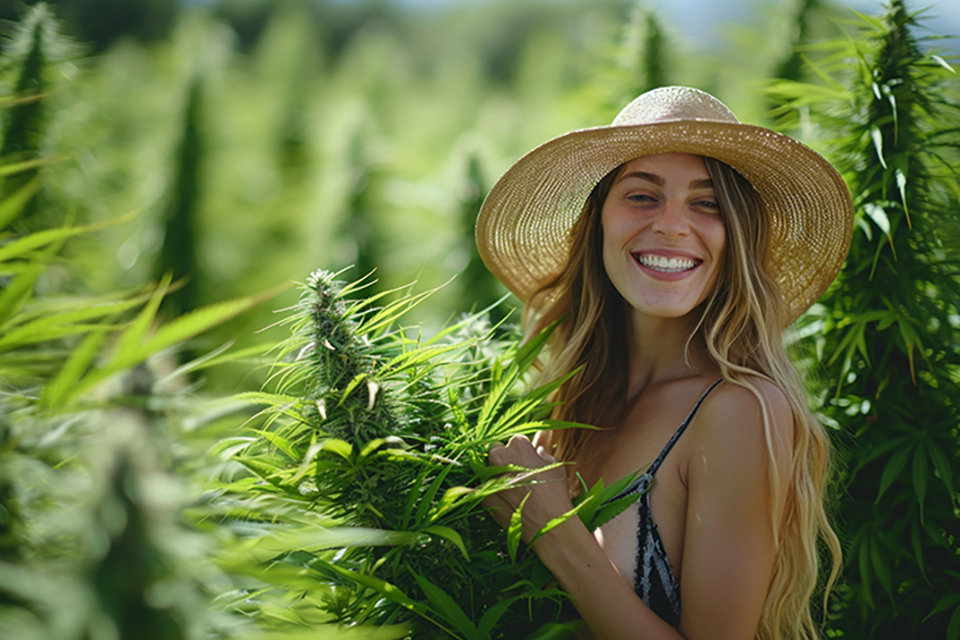
Growing large cannabis trees is a rewarding experience for home growers looking to maximize their yield and quality of harvest. Selecting the right strains, optimizing the growing environment, and implementing effective training techniques can help you grow healthy and robust cannabis trees that will yield impressive results.
Selecting the Right Cannabis Strain
Several cannabis strains, including Orange Skunk Feminized and Blue Headband Feminized, are particularly suitable for growing into large cannabis trees. Both strains are available for purchase at reputable seed banks like Kind Seed Co.
Orange Skunk Feminized is a hybrid strain that is well-known for its resilient nature and impressive yield, making it an excellent choice for growing into a large tree. This strain thrives in sunny climates and responds well to training, with a strong stem structure that can support its heavy buds. In contrast, Blue Headband Feminized is a high-yielding strain that grows tall and features ample internodal spacing. This open structure allows light to penetrate deeper into the plant, ensuring more even growth and a larger overall size.
Optimal Growing Environment
Indoor cultivation can offer superior control over environmental factors. This control can positively impact your cannabis trees’ growth, yield, and longevity.
Outdoor cultivation gives trees space to grow large, but it leaves them vulnerable to pests, diseases, and fluctuating weather conditions. On the other hand, indoor cultivation gives you greater control over temperature, humidity, and light schedules, which can maximize yield and plant health. Indoor setups can also deter pest infestations and diseases.
Soil and Nutrient Management
A rich, well-draining soil is vital for growing cannabis trees. The soil should be loamy and contain a balanced mixture of sand, silt, and clay. This ensures good water retention while allowing excess moisture to drain away, preventing problems such as root rot.
Adding organic matter, such as compost, can help improve soil fertility and structure. It can also promote beneficial microbial activity, leading to healthier, stronger plants. Cannabis trees prefer slightly acidic soil, with a pH between 6.0 and 7.0. Regular soil testing is helpful to monitor and maintain optimal soil pH and nutrient levels.
Training and Pruning Techniques
Low-stress training (LST) is a gardening technique used to manipulate the plant’s shape and size while minimizing stress. LST involves gently bending the branches and securing them in place to create a more horizontal structure. This increases light exposure to all parts of the plant, thus promoting a more uniform and expansive growth.
To prune, remove lower branches that receive minimal light and show slow growth. Also, remove dead or yellowing leaves that could be a sign of disease or infestation. Always ensure you use clean, sharp tools for pruning to avoid spreading disease.
Light and Water Management
Effective management of light and water is another crucial step in achieving large and healthy cannabis trees. These two factors heavily influence the plant’s photosynthesis process, which in turn directly affects its growth and yield.
Cannabis trees require abundant light to grow tall and healthy. This involves the intensity, duration, and quality of light. Indoor growers often use full-spectrum LED lights that mimic natural sunlight, providing all the light frequencies necessary for optimal growth.
Pest and Disease Control
Several pests and diseases can affect cannabis trees. The most common pests include spider mites, aphids, and whiteflies. These small insects can cause considerable damage by feeding on the cannabis plant’s sap, leading to curling, yellowing, and dropping of leaves.
Diseases often affecting cannabis trees include powdery mildew, a fungal disease that appears as a white powdery substance on leaves, and root rot, often caused by overwatering and poor drainage. Both pests and diseases can drastically reduce the yield and overall health of your cannabis trees if left untreated.
Harvesting and Curing Tips
When it comes to harvesting, timing is everything. Harvest too early, and you compromise potency and yield; too late, and you might lose some unique strain flavors. A common method is to observe the color change in the trichomes (small hair-like outgrowths on the buds). When half of them have turned from clear to cloudy, it’s time to harvest.
For large cannabis trees, you might harvest in stages due to their size. Start from the top and methodically work your way down, carefully cutting off sections of the plant. Always use a sharp, clean tool to avoid causing unnecessary stress to your plant.
Curing Methods to Preserve Quality and Potency
After drying, growers must trim the buds from the branches and place them in jars to begin the curing process. This process lets the remaining moisture escape slowly from the buds, enhancing their taste and potency. Open the jars for a few minutes each day to let fresh air in, a process known as “burping.”
Proper curing can take between two to four weeks, but some cannabis connoisseurs cure their buds for up to six months for smoother smoke. Through patience and careful attention, you can maximize the potential of your large cannabis trees, resulting in a high-quality product that is worth the months of work.
The Journey to Large Cannabis Trees
Growing large cannabis trees is a journey that requires time, patience, and a good deal of care. Selecting the right strain, creating an optimal growing environment, and attentive care will help you to grow healthy, robust cannabis trees.
Continue experimenting with different strains and techniques and staying engaged with the grower community. Your next harvest could be your best one yet. Remember, every challenge faced is an opportunity to gain experience.



